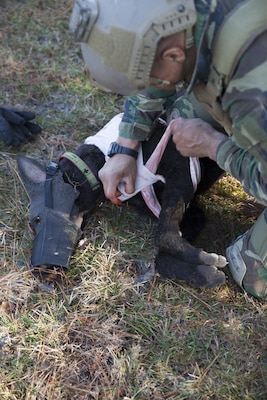By Marine Corps Cpl. Bryann K. Whitley, U.S. Marine Corps
Forces, Special Operations Command
CAMP LEJEUNE, N.C., Dec. 8, 2017 — Multipurpose canine
handlers with U.S. Marine Corps Forces, Special Operations Command, used a
robotic canine training mannequin for the first time during hands-on medical
training at Stone Bay here between Nov. 30 and Dec. 1.
The simulator, one of two prototypes being developed between
U.S. Special Operations Command and industry partners, challenged handlers and
medical staff with the wide range of scenarios available through its realistic
reactions to injuries and treatments.
‘Robot Dog’ Mannequin
The development of this new “robot dog” came from Socom’s
desire to improve the current medical training capabilities of canine handlers.
Currently, the special operations forces community uses stuffed dogs, called
critical-care jerry dogs, to train and refine medical techniques and procedures.
The static nature of the jerry dogs limits the instructors’
ability to evaluate dog handlers’ and medical team members’ capabilities to
properly perform medical aid on canines. The service members also heavily rely
on force veterinarians to provide scenarios and injury descriptions, which
limit training opportunities to garrison training environments due to
unavailability of veterinarians in a deployed environment.
“Our handlers are the first line of aid for their dogs when
deployed, secondary to special amphibious reconnaissance corpsmen,” said a
MARSOC East force veterinarian. “They are the first responders, so they need to
know how to treat any injury that happens on the battlefield.”
All Joints Move Like a Real Dog’s
Socom’s desire to provide better training and increased
capabilities to deploying teams kick-started the development of this new “robot
dog.” The prototype is designed to look like a Belgian Malinois, one of the
commonly used breeds in the military canine force. All of the joints on the
mannequin move like a real dog’s, unlike a jerry dog where there is no
movement. Limbs can also be changed out, to simulate different injuries
depending on the training scenario’s objectives.
Some possible injuries include lacerations on paws and legs,
as well as fractures. Supervising veterinarians can have injuries release
simulated blood, change respiration or pulse rate and quality, as well as have
the mannequin produce barking or whining noises, all of which improve the
realism of the training.
Canine handlers must rely on their own knowledge and senses
to determine what injuries are present. Handlers must go through a step-by-step
process to determine how to best administer aid to their canines in order to
stabilize them and get them to a veterinarian.
“[Having this capability during training] helps you not
second guess yourself when deployed,” said a MARSOC canine handler. “You’re
able to realize that you’ve used these steps before in training. And they
worked in training so they will work when needed. As long as you continue with
the steps and do everything properly, you’ll be successful and save your dog.”
Useful Capabilities
With the additional capabilities provided from the
prototype, handlers can practice a wider range of scenarios including
performing a tracheotomy or intubation, full CPR with reactive responses,
administer IVs, and practice counteracting evisceration injuries.
When proper medical aid is administered, handlers can see
vitals stabilize in moments and verify they are applying aid properly. All of
these training advancements allow for a more thorough and advanced training for
handlers to help aid their furry partners on the battlefield.
Production for this new prototype is planned to start in
March 2018, after feedback from the final training iterations has been
reviewed. Once fielded, the training device will be made available across the
military canine force, potentially as early as April 2018.

No comments:
Post a Comment